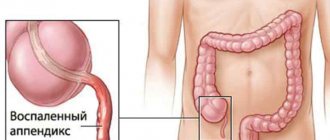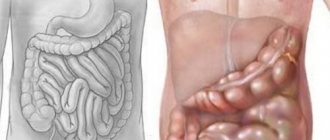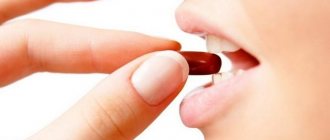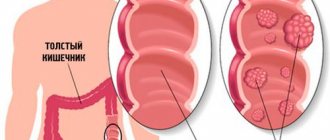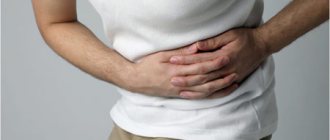Causes of intestinal adhesions
The main reasons for the formation of intestinal adhesions are:
- closed and open injuries in the abdominal area;
- inflammation or infection of the peritoneum;
- operations performed;
- genetic predisposition.
After suffering an abdominal injury, intestinal adhesions may form after some time. The formation process is quite long and can take a period of six months or more.
It is not uncommon for a pathophysiological process to begin to develop after inflammation of the appendix.
An infection of the abdominal cavity, during which an intestinal adhesion is formed, is called peritonitis.
But most often, operations performed in the abdominal cavity lead to the occurrence of adhesions.
With a genetic predisposition, any provoking factor can lead to development. These include poor diet, alcohol and nicotine.
The development of pathogenesis is also observed in abdominal obesity, which leads to inflammatory processes against the background of excess adipose tissue in the area of the greater omentum.
Mechanisms of pathology development
The peritoneum is a thin film that envelops the organs inside. Between these organs there is a small amount of liquid in which they remain “as if in weightlessness,” moving relative to each other within acceptable limits.
When any inflammation occurs, the peritoneum seems to “stick” to the affected area, isolating the source of inflammation and preventing it from spreading to nearby tissues.
A seemingly useful function can play a cruel joke - the layers of the peritoneum have the property of adhesion. And if the required amount of fluid inside is not restored in time, then an adhesive process occurs.
Adhesive disease is another matter. This is already a pathology that has certain clinical manifestations, depending on the location of the process.
The disease is classified according to several criteria:
- Clinical course: uncomplicated and complicated;
- prevalence of the adhesive process: local, limited, subtotal and total;
- influence on intestinal functions: without disturbance, with complete or partial disturbance.
Also, when prescribing treatment, the localization of adhesions in the abdominal cavity, the characteristics of the “strands” themselves, and the shape and size are taken into account.
Adhesions in the intestines: symptoms
Adhesive disease may not be noticed due to its asymptomatic course. But if the pathophysiological process begins to manifest itself, then the first sign is pain in the abdominal cavity or pelvis.
The main symptoms of intestinal adhesions:
- nagging pain and spasms;
- increased flatulence;
- constant rumbling in the stomach;
- regular constipation.
Spasms and nagging pain may occur with greater intensity after eating or physical activity.
Dyspepsia, accompanied by increased gas formation, rumbling, indigestion and bloating, is also one of the symptoms of intestinal adhesions. Nausea or a gag reflex may occur after eating. With the chronic course of the process, loss of body weight is also observed.
Constipation during adhesions occurs as a result of impaired intestinal motility.
Symptoms of the disease
Signs of the adhesive process do not appear immediately. Often the pathology develops unnoticed by the patient. Clinical manifestations of the disease are absent or blurred. However, sooner or later, usually when the adhesion process has gone far enough, a person develops characteristic symptoms of the formation of intestinal adhesions:
p, blockquote 5,0,0,0,0 –>
- Pain syndrome in the abdominal area. It occurs precisely in the area where the integrity of the tissues has been compromised due to surgery or injury. Usually accompanies heavy physical exertion, activity that is accompanied by turns, bends of the body and torso. The pain is nagging in nature.
- Various digestive disorders. These are flatulence, bloating, rumbling, hiccups, heartburn, belching, nausea and vomiting, diarrhea or systematic constipation. Pain during bowel movements in the abdomen and rectum. Such symptoms arise because the intestines are compressed and deformed, and the vessels feeding it are also pinched.
- Signs of intoxication of the body are weight loss, change in skin color (pallor, greyness), general weakness, fever.
If a person experiences these symptoms after an abdominal injury or surgery, they should consult a doctor. After all, advanced intestinal adhesive disease can cause serious complications.
p, blockquote 6,0,0,0,0 –>
Possible complications
Intestinal adhesions, the symptoms of which most often do not appear for a long period, can lead to serious complications. Patients seek help when complications such as intestinal obstruction or partial intestinal necrosis begin to appear.
Intestinal obstruction manifests itself as a complete or partial disruption of the movement of contents through the digestive system as a result of compression of the intestine.
Partial intestinal necrosis is the necrosis of a section of the intestine in the area of commissure. Pathology occurs due to impaired blood supply to the affected area.
Possible complications and prognosis
Possible complications of intestinal adhesions include:
- adhesive intestinal obstruction;
- peritonitis;
- sepsis;
- necrosis of intestinal loops.
In most cases, the prognosis for patients with intestinal adhesions is favorable. Complications arise only in advanced cases when intestinal obstruction develops. However, if this disease is left untreated, the patient's condition can deteriorate sharply, and in severe cases, death is possible.
First of all, let's define what adhesions are. These are peculiar cords formed by connective tissue that interfere with the functioning of internal organs. The most common adhesions in the pelvis are intestinal adhesions. Why is this happening?
Diagnostics
To diagnose intestinal adhesions, the following examination is performed:
- radiography;
- Ultrasound of the abdominal cavity;
- laparoscopy;
- blood analysis.
X-rays of the intestines are performed on an empty stomach using oral barium, which helps determine the presence of affected areas as the intestines fill.
An ultrasound examination is also prescribed on an empty stomach. Before an ultrasound examination, it is not allowed to eat foods rich in fiber, since due to the formation of gases in the intestinal loops, incorrect data can be obtained.
During laparoscopy, a special tube with a camera and lighting is inserted into the abdominal cavity, which makes it possible to study the intestinal loops in more detail and verify the presence or absence of adhesions.
A clinical blood test helps determine the presence or absence of an inflammatory process in the body due to the erythrocyte sedimentation rate, namely, ESR.
Homeopathy
Treatment of adhesions without surgery using homeopathic remedies can only be used as an auxiliary element of complex conservative therapy. The dosage and regimen of use is calculated individually for each clinical case. Homeopathic specialists recommend using the following herbal preparations:
- Aconitum Napellus C6 (derived from turnip grass extract);
- Staphysagria drops or Arnica Montana granules (active ingredient – larkspur seeds);
- Bellis Perennis drops (active ingredient – daisy extract).
- How to congratulate a girl on her birthday
- Chops in the oven - recipes with photos. How to cook a delicious baked chop
- How to treat fingernail fungus
Drug treatment
If intestinal adhesions do not interfere with the patient’s quality of life, conservative treatment is carried out with medications.
Enzyme preparations that have a resolving effect are prescribed. These include Hyaluronidase.
Urokinase or Fibrinolysin can be prescribed as intravenous infusions. Contraindications to their use are internal bleeding or recent surgery.
After surgery, to prevent the formation of intestinal adhesions, the anticoagulant Heparin is injected into the subcutaneous fatty tissue.
If spasms and nagging pain occur, No-shpa, Spazmalgon and Paracetamol are prescribed.
Prevention
If a person once develops an adhesive disease, it is not enough to simply cure it and forget about it. Only regular prevention of pathology can guarantee complete relief from the problem. And also prevent the occurrence of the disease in the future.
p, blockquote 23,0,0,0,0 –>
After the operation, you should start moving as soon as possible, doing feasible physical exercises and breathing exercises. Upon leaving the medical facility, as well as during and after drug therapy, you need to adhere to the correct diet. The daily menu and diet are compiled taking into account the recommendations of the attending physician. Measured work of the gastrointestinal tract, an active lifestyle, and avoidance of abdominal injuries are a guarantee that adhesive disease will not occur in the future.
ethnoscience
Traditional medicine helps to relieve spasm and pain to a greater extent.
For this purpose, a decoction based on chamomile, peppermint and calamus root is used. All components are mixed in equal proportions to obtain a tablespoon of the mixture. The mixture is poured with a glass of boiling water and left for half an hour. The resulting decoction is drunk in small sips throughout the day. The product helps to significantly reduce spasm.
According to supporters of traditional medicine, juniper tincture has a therapeutic effect on intestinal adhesions. To prepare the medicine, take two tablespoons of crushed plant bark per glass of vodka or 40% alcohol. The tincture is infused for three weeks in a dark place. After this, the remedy can be taken one teaspoon before meals three times a day.
Traditional methods of treatment
If minor symptoms appear, treatment with folk remedies can be quite effective. Natural pharmacy has prepared a lot of active remedies for this phenomenon.
If a patient has intestinal adhesions, treatment with folk remedies can be carried out in the following ways:
- Take 100 grams of decoction of rosehip, raspberry and mulberry leaves three times a day. The plants need to be mixed in equal proportions and poured with a glass of water. After a few hours, you can drink the drink.
- Pain from adhesions will go away with a decoction of rose hips, lingonberries and nettles. You need to drink this medicinal drink twice a day, half a glass.
- You can prepare a tincture from mother and stepmother and millennium. Taking 1 tbsp. each of the plants and adding a glass of water, you need to drink it several times a day.
- Bergenia is a very effective remedy in the fight against this enemy. Any part of the plant should be poured in the amount of one tablespoon into 200 grams of boiling water, infused, and drunk morning and evening.
- You can brew St. John's wort in a jar and drink this decoction; it helps very well with intestinal adhesions.
- Aloe also has excellent absorbable properties, and in order to use it you need to grind it in a meat grinder or using a blender, add honey and oil. This remedy should be taken with warm milk, to which you need to add 1 bed of the medicinal composition.
This is a small part of the remedies that help the body get rid of adhesions and discomfort in a natural way and without side effects. Treatment of adhesions with folk remedies often leads to success.
But it is worth remembering that if the condition does not change, and the patient still feels pain and other disorders, then you need to contact a doctor as quickly as possible, perhaps the degree of difficulty is very serious, and here nature is powerless, and professional help is needed.
Diet therapy
Nutritional correction is prescribed in the preoperative and postoperative periods.
The patient must avoid eating foods high in fiber and foods that cause increased gas formation. This category includes all legumes, cabbage, milk, grapes, sparkling water, etc.
The patient's diet should consist of the following dishes:
- weak chicken broth;
- boiled chicken breast;
- omelet or soft-boiled eggs;
- cottage cheese and fermented milk products.
Meals should be taken in small portions up to 4-6 times a day.
Symptoms and first signs
While the connective tissue is still soft and has not had time to grow or stick together, no negative manifestations occur. Over time, abdominal discomfort appears. If the pain is ignored or attributed to other unfavorable conditions, the adhesions become even larger and harden.
Most often, the following signs of an unfavorable condition appear:
- Nagging pain in the epigastric region, which intensifies after physical labor.
- Signs of dyspepsia: bloating, flatulence and diarrhea.
- Chronic constipation, caused by partial closure of the lumen of the small intestine, which makes it difficult for feces to pass through.
- In severe cases, complete intestinal obstruction occurs.
- In women, if the fiber has grown in the genital area, there is infertility of unknown origin (hormonal levels are normal, there are no physiological abnormalities).
- Intestinal adhesions symptoms treatment in adults
- Ulcerative colitis of the intestine - symptoms, treatment
- Intestinal disorder symptoms treatment in children
- Intestinal dyskinesia in children: symptoms and treatment
Surgical method
Surgical intervention is performed in the presence of many adhesions and in the case of a chronic process.
In case of an extensive pathological process, an incision is made in the abdominal cavity and the resulting adhesions are dissected. But when treated with this method, every third patient develops adhesive joints again.
Single adhesions can be removed using laparoscopy. A special device with a camera is inserted into the abdominal cavity through a small incision and excision is performed. This method in most cases leads to positive dynamics of treatment.
Treatment
Therapeutic tactics depend on the severity of pain and functional disorders of the intestine. Compliance with a special diet also plays a great role in successful therapy.
Diet
It consists of avoiding rough and heavy foods, which can cause increased peristalsis and gas formation. The following foods are prohibited: cabbage, whole milk, soy products, all types of legumes, carbonated drinks, grapes, hot spices.
Patients are recommended to eat small portions at strictly defined times, as this normalizes intestinal function.
Conservative treatment
In the presence of “silent” adhesions, no special treatment is required. Observation and periodic preventive examinations by a doctor are sufficient. All conservative treatment methods are effective only for mild forms of the disease or as preventative measures.
If there is minor pain and mild functional disorders, analgesics and antispasmodics are prescribed to eliminate spasm of the intestinal muscles.
Sometimes it is effective to prescribe drugs that limit the formation of adhesions and their partial resorption. These are the injections:
- vitreous body,
- splenina,
- aloe preparations,
- enzymes (trypsin, chymotrypsin, lidase).
Operation
The problem with surgical treatment of intestinal adhesions is the fact that any abdominal surgery can cause re-formation of the adhesive process.
Therefore, surgical interventions are performed with minimal trauma. Instead of cutting the detected adhesions with a sharp instrument, they are often hydraulically compressed (in this case, a special liquid is injected into the connective tissue cord under pressure, which destroys it).
The separation and cutting off of adhesions is usually complemented by enetroplication - restoration of the normal anatomical position of the intestine. In this case, the intestinal loops are carefully laid in a horizontal or vertical direction and stitched together.
To reduce the scope of the operation and the risk of the formation of new adhesions, laparoscopic intervention is often used.
Causes
What are intestinal adhesions? Delving deeper into the processes of development of pathology, we can say that the proliferation of connective tissue is the body’s protective reaction to injury to the layers of the peritoneum. Thus, depending on the localization of the pathological process, adhesions can develop in different parts of the intestine between each other, the layers of the peritoneum and other abdominal organs.
The most common causes of adhesive disease are surgical interventions. The greatest risk is associated with operations performed using the laparotomy method (through a median dissection of the abdomen and parietal peritoneum). However, other reasons contribute to the development of the disease:
- mechanical injury to the abdominal organs (intestines, spleen, liver, gall bladder, etc.);
- the presence of an acute inflammatory focus in the abdominal cavity (appendicitis, peritonitis);
- in women, the etiological factor of adhesive disease can be Caesarean section;
- hereditary predisposition, where the occurrence of adhesions is facilitated by increased activity in the body of enzymes responsible for the formation of connective tissue;
- radiation exposure (for example, during the treatment of oncology);
- in children, the occurrence of adhesions can be caused by congenital anomalies of the digestive tract (dolichosigma, atresia, intussusception).
In addition to the main reasons, there are factors that contribute to the adhesive process. These include poor nutrition, physical inactivity, abdominal obesity, as well as uncontrolled use of certain medications.
Symptoms
Intestinal adhesions may not show any symptoms for a long time, since they form quite slowly. Typically, such pathology is detected through preventive examinations or repeated surgery. The severity of the clinical picture of adhesive disease depends on the location, extent of the proliferation of connective tissue, as well as the cause of the pathological process.
Uncomplicated form
Adhesions that do not lead to disruption of trophism and narrowing of the intestinal lumen have two main syndromes in their clinical picture:
- Pain syndrome . The pain is nagging, aching, and in some cases spastic in nature. The localization of unpleasant sensations depends on the location of the formation of adhesions: in case of damage to the large intestine - on the sides, in the lower abdomen, in the small intestine - in the umbilical region. This symptom is provoked by physical activity and dietary errors.
- Dyspeptic syndrome . Dyspeptic syndrome refers to nausea, belching, and coated tongue. Intestinal motility disorders often appear - diarrhea or constipation occurs (most often constipation is observed when the sigmoid colon is affected). Increased gas formation (flatulence) is observed.
In women with intestinal adhesions that involve the internal reproductive organs, menstrual irregularities and difficulties with pregnancy (if the fallopian tubes are damaged) may develop.
Typically, the clinical picture of intestinal adhesions appears in attacks - general well-being is abruptly replaced by unpleasant symptoms. The constant presence of manifestations of the disease indicates its chronicity.
Complicated form
The most common complication of adhesions is intestinal obstruction. This pathology may appear due to a narrowing of the lumen of the organ and disruption of its trophism. In this case, the patient's condition worsens and emergency medical care is required.
Symptoms of a complicated form are:
- spasmodic abdominal pain;
- non-discharge of feces and gases;
- hyperthermia;
- pale skin, cold sticky sweat;
- weakness, fatigue;
- nausea, vomiting (first with gastric contents, then with intestinal contents);
- with a complex course, tachycardia and hypotension occur.
The sudden disappearance of the above manifestations is a sign of the development of necrosis (tissue death) of the affected area of the intestine. This condition is an indication for urgent surgery.
How to eat healthy
When intestinal adhesions occur, proper nutrition is necessary. A special diet eliminates both overeating and undereating in order to avoid complications and aggravation of the problem. The regime and its careful observance are important - you will need to get used to having meals at a certain time.
Food intake should be fractional, for which the portion sizes and time intervals between their consumption are reduced. You should have meals 5 or 6 times within 24 hours. Heavy dishes, fatty foods, and elements excessively enriched with fiber, the consumption of which leads to flatulence, should be removed from the menu.
The list of prohibited and not recommended products includes:
- Legumes, corn.
- Cabbage, radishes and turnips.
- Grape.
- Whole fat milk.
- Soda and coffee drink
- Sauces, savory and hot seasonings.
- Marinades, smoking and canned food.
Fermented milk dishes, especially low-fat kefir, are of great benefit; their consumption improves the movement of intestinal contents. At the same time, it is advisable to drink kefir before going to bed at night. Allowed dishes also include low-fat broths, boiled or steamed fish, scrambled eggs or hard-boiled eggs, and boiled lean poultry.
Proven fact. The temperature of the food consumed is also important - they should be warm, which will relieve intestinal spasms.
Ласковые проверенные феи проститутки в Самаре, сладкие и ухоженные, они такие интересные и привлекательные, что тебе обязательно повезёт. Выбери девушку сейчас. Встречаются только в пределах полного разврата, проверенные феи проститутки в Самаре, фото свои, не типаж - dosugsamary.ru. Если говорить конкретно, то с проститутками можно заняться не только классическим сексом, но и всем, чем пожелаете.
